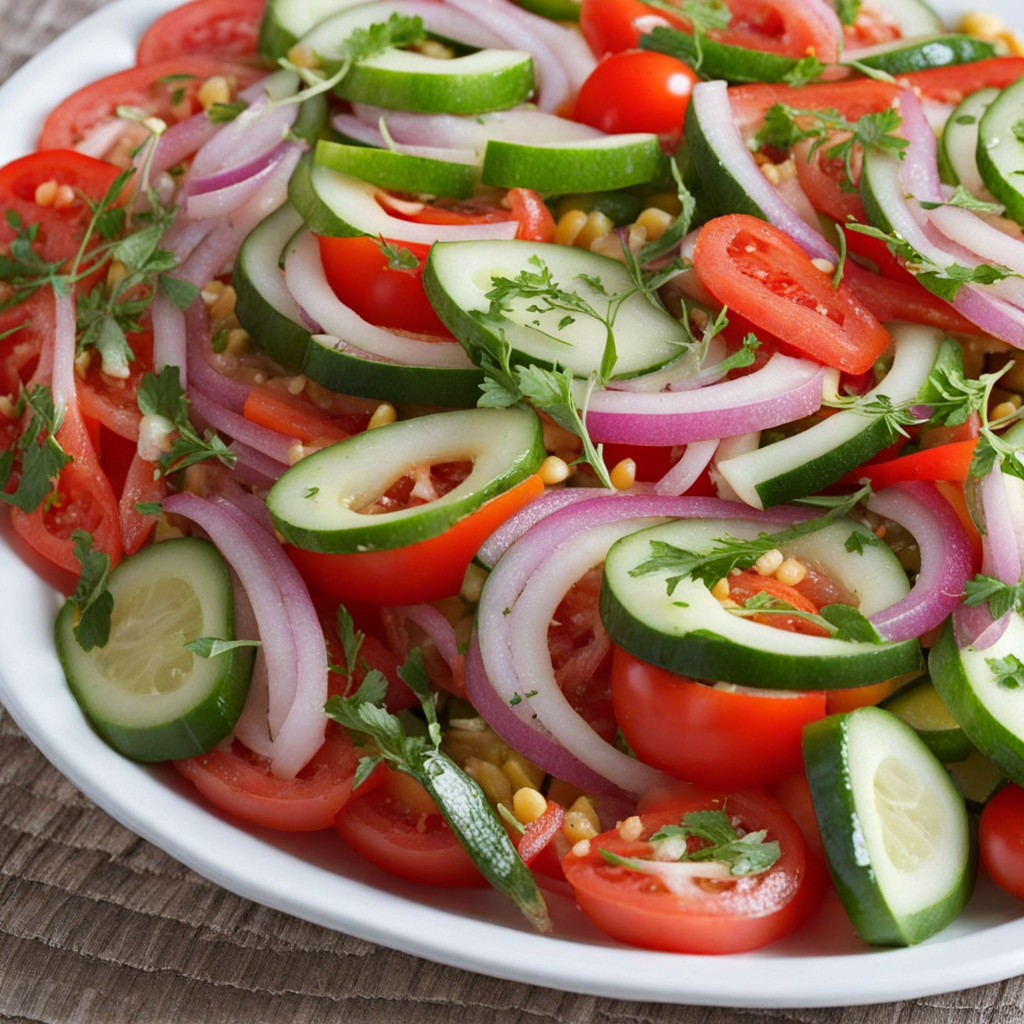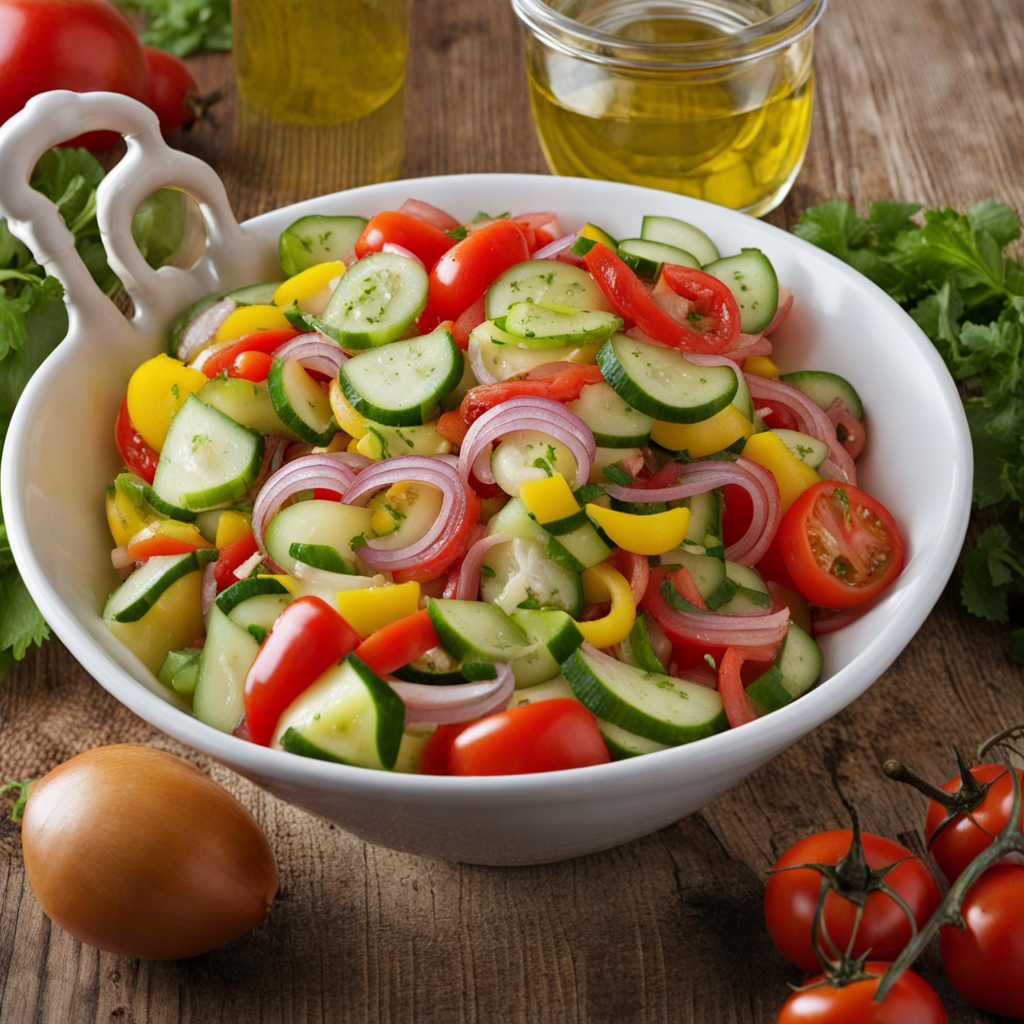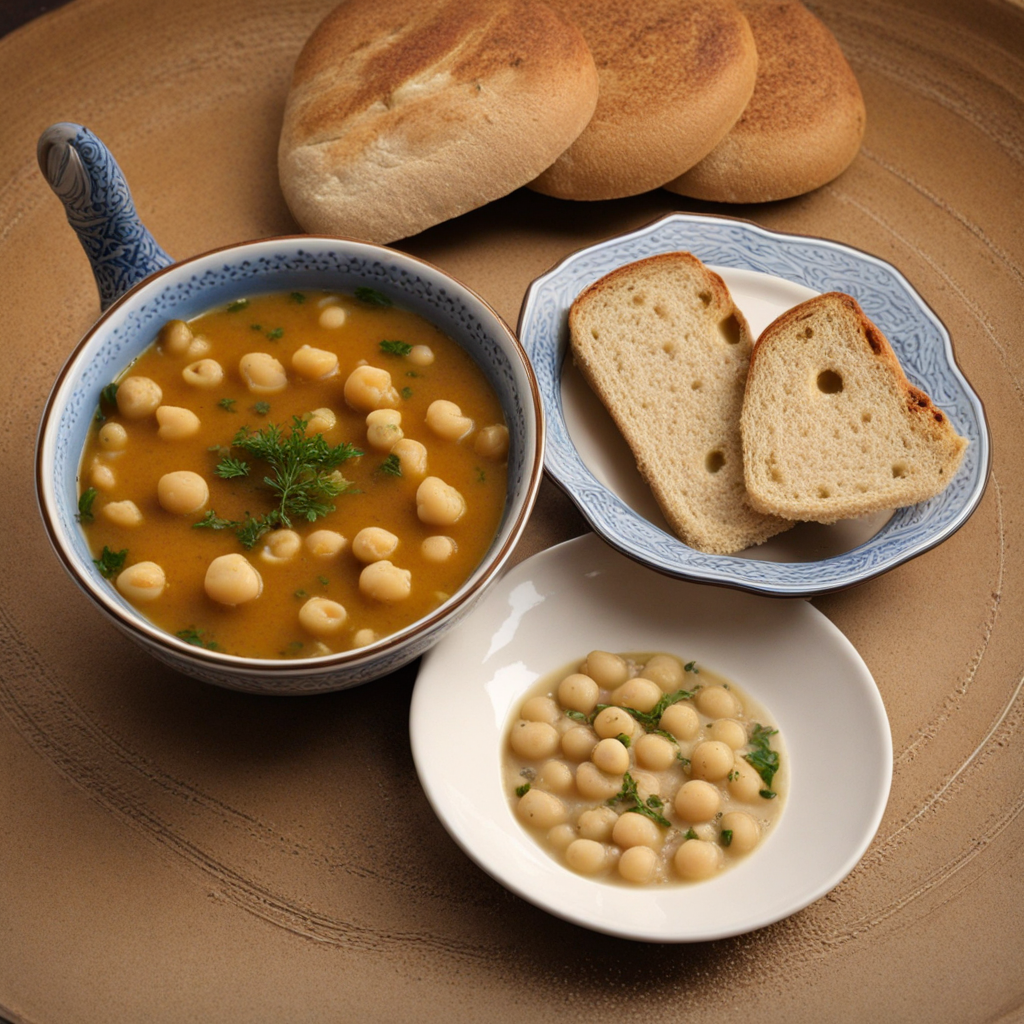Tunisian Salad
Tunisian Salad is a vibrant and refreshing dish that beautifully encapsulates the essence of Mediterranean flavors. This salad typically features a colorful medley of fresh vegetables, including ripe tomatoes, crisp cucumbers, and crunchy bell peppers, all finely chopped and tossed together. The addition of red onion adds a zesty bite, while olives bring a briny depth. This salad is often garnished with fresh herbs like parsley and mint, which enhance its aromatic profile and add layers of flavor. The dressing for Tunisian Salad is a simple yet bold combination of olive oil, lemon juice, and a touch of harissa, a spicy chili paste that is a staple in Tunisian cuisine. This dressing not only elevates the salad but also introduces a delicate heat that complements the freshness of the vegetables. Some variations might include chickpeas or tuna, which add protein and make the dish more filling, perfect for a light lunch or as a side dish for a larger meal. What makes Tunisian Salad truly special is its versatility; it can be served as an appetizer, a side, or even a main dish, depending on the ingredients used. It embodies the spirit of sharing and enjoying food, often accompanied by crusty bread to soak up the delicious juices. Each bite offers a delightful crunch and a burst of flavor, making Tunisian Salad a must-try for anyone looking to explore new culinary horizons.
How It Became This Dish
The History of سلطة تونسية (Tunisian Salad) Tunisian salad, or "سلطة تونسية," is a vibrant and flavorful dish that embodies the rich culinary heritage of Tunisia. Known for its fresh ingredients and varied textures, this salad has become a staple in Tunisian households and is often enjoyed in restaurants around the world. To understand the cultural significance and historical development of Tunisian salad, we must delve into the origins of its components, the evolution of its preparation, and its role in Tunisian society. Origins: A Melting Pot of Influences Tunisian cuisine is a product of the country's diverse history, influenced by various civilizations that have occupied or traded with the region. From the ancient Phoenicians and Romans to the Arabs, Ottomans, and French, each culture has left an indelible mark on the culinary landscape. The origins of Tunisian salad can be traced back to the Mediterranean diet, which emphasizes the use of fresh vegetables, legumes, and herbs. The primary ingredients of the salad—tomatoes, cucumbers, bell peppers, onions, and olives—are staples in Mediterranean cooking and reflect the agricultural bounty of the region. Tunisia’s climate, with its long, hot summers and mild winters, is particularly conducive to growing these vegetables, making the salad both accessible and appealing. The use of spices, particularly harissa (a fiery chili paste), reflects the Arab influence on Tunisian cuisine, as well as the Berber tradition of flavoring dishes with bold, aromatic ingredients. Harissa is often served as a condiment alongside the salad, adding heat and depth to the dish. Cultural Significance: A Symbol of Hospitality and Community In Tunisian culture, food is an integral part of social life, and salads hold a special place at the table. سلطة تونسية is often served as a starter during family gatherings, weddings, and celebrations, symbolizing hospitality and generosity. The salad is typically placed in the center of the table, allowing everyone to share and enjoy it together. This communal aspect of dining is central to Tunisian culture, where the act of sharing food fosters connections among family and friends. The salad's vibrant colors and fresh ingredients also reflect the importance of seasonal eating in Tunisia. The use of local produce not only supports local agriculture but also connects people to the land and its cycles. As a result, سلطة تونسية is more than just a dish; it is a celebration of the region’s agricultural heritage and a testament to the importance of community and togetherness. Development Over Time: From Traditional to Modern Traditionally, سلطة تونسية was prepared using whatever fresh ingredients were available, resulting in a dish that could vary significantly from one household to another. The basic components—tomatoes, cucumbers, and peppers—have remained constant, but the inclusion of other ingredients, such as chickpeas, tuna, or boiled eggs, has evolved over time. In the early 20th century, as Tunisia began to modernize under French colonial rule, the influence of French cooking and culinary techniques began to seep into Tunisian cuisine. The French introduced new types of produce and methods of preparation, which gradually found their way into traditional dishes. This period saw the incorporation of higher-quality olive oil and vinegar in the dressing of سلطة تونسية, elevating its flavors and presentation. As Tunisia gained independence in 1956, there was a renewed interest in national identity and heritage, including the revival of traditional dishes. Culinary schools emerged, and chefs began to experiment with traditional recipes, often incorporating modern techniques while respecting the essence of Tunisian flavors. This led to a renaissance of Tunisian cuisine, with سلطة تونسية being reinterpreted in various ways, from gourmet presentations in upscale restaurants to street food versions sold in markets. The Contemporary Scene: Global Recognition In recent years, Tunisian salad has gained international recognition, becoming a popular dish in Mediterranean and Middle Eastern restaurants worldwide. The increasing interest in healthy eating has further propelled its popularity, as the salad is not only nutritious but also visually appealing. Its combination of fresh vegetables, healthy fats from olive oil, and the unique kick from harissa makes it a favorite among food enthusiasts looking for vibrant and wholesome dishes. As the global food scene continues to evolve, many chefs are taking creative liberties with سلطة تونسية, incorporating elements from other cuisines while still honoring its traditional roots. For instance, some chefs might add quinoas or avocado, reflecting global culinary trends, while maintaining the essential characteristics of the salad. This fusion of flavors has helped introduce Tunisian salad to an even broader audience, sparking interest in other aspects of Tunisian cuisine. Conclusion: A Dish of Unity and Identity سلطة تونسية is more than just a salad; it is a dish steeped in history, culture, and community. Its origins reflect the myriad influences that have shaped Tunisian cuisine, while its evolution showcases the adaptability of traditional foods in a modern context. Today, it serves as a symbol of Tunisian identity, representing the country’s agricultural bounty and the importance of shared meals in fostering relationships. As people around the world continue to discover and appreciate the flavors of Tunisia, سلطة تونسية remains a beloved dish that invites everyone to gather around the table, share stories, and celebrate the simple joys of good food and good company. Whether enjoyed in the streets of Tunis or in homes across the globe, this salad encapsulates the essence of Tunisia: vibrant, diverse, and deeply connected to the land and its people.
You may like
Discover local flavors from Tunisia







